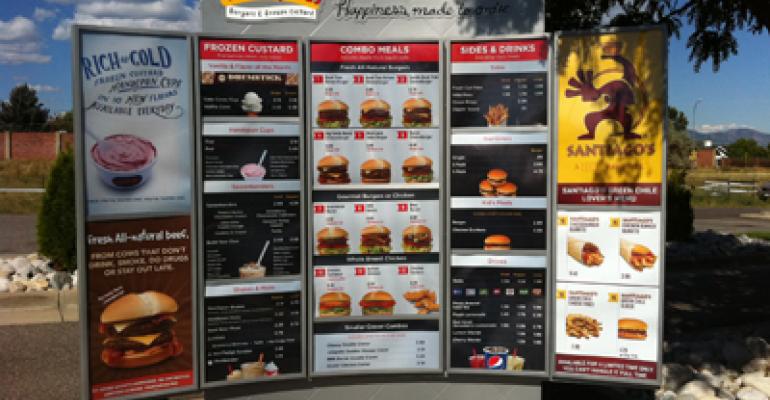The Good Times Burgers & Frozen Custard chain is undergoing a refresh of its image and operations to better compete in a crowded world of “better burger” players.
The move comes after investment group Small Island Investments Ltd. acquired a majority stake of Golden, Colo.-based parent Good Times Restaurants Inc.’s outstanding shares in a deal that closed last December.
Other restaurant investments by Boston-based Small Island have included the Piccadilly Pub chain in Massachusetts, and the Elephant & Castle Group Inc., which filed for Chapter 11 reorganization in July.
For Good Times, the investment has brought working capital to re-energize the brand and allow the company to look for growth opportunities, including the possibility of investment in another concept.
Boyd Hoback, president and chief executive of the 46-unit chain, spoke with Nation’s Restaurant News about the brand’s renewed momentum.
What has Small Island brought to the brand?
We’re still a NASDAQ small-cap company, but it has brought working capital to implement a lot of the initiatives we’ve been working on over the past year. We’ve had 13 months of consecutive same-store sales increases.
Right now we’re rolling out all new menu boards and a new graphics platform. We’ve had the same package for about 10 years or so, so it’s an updating and re-energizing of the brand.
The theme is “Happiness Made to Order.” That reflects our earlier move to a made-to-order platform. We started with our fresh-cut fries last year, which are now cooked to order. We’re now testing in two units a made-to-order platform for our burgers.
Isn’t that a significant change in your operations?
Yes it is. We knew it would compromise our speed of service a bit, but consumers see it as a much better product.
Continued from page 1
And you’re using local products?
We have embarked on trying to line up more regional and local ingredients, which is part of our fresh and hand-crafted story. We have always used all-natural beef, fresh-cut tomatoes and fresh-made lemonade. This month, we announced a new product line up that includes [Denver-based] Santiago’s Authentic Green Chile. We were looking for an authentic Hatch Valley [Nevada] green chile and we felt the best one was Santiago’s.
We’re also working with a local craft brewer on a beer-battered onion ring.
Last year, we rolled out hand-spun shakes and tripled that category. Sales of our fries also increased with the made-to-order shift. And we have a quarterly “Lovers” theme for limited-time offers, like bacon lovers or onion lovers.
We’re also re-engineering our chicken category. We’re doing consumer research now. We have engaged Real Food Matters in Boulder, Colo., and they helped us to develop some new prototypes. We’re looking at an entirely new protein platform and new products.
Different from the chicken you have now?
We have a grilled chicken and crispy chicken, but they are a commoditized product. Our goal is to become not commoditized.
You recently hired a new advertising agency?
Sukle Advertising. From a marketing standpoint, we’re doing a new loyalty program. A new social-media strategy will launch, but we’re still designing that. We’re also looking at our broadcast support and increasing our radio broadcast media.
Continued from page 2
Can you describe the new look?
On the graphics side, it’s a new design that refreshes our packaging, the building exteriors and signage. That will roll out over the next year. Within the next 45 days, we’ll have the first unit re-imaged, but we’re not sure which it will be yet.
What’s the thinking in terms of growth?
We have 46 units now, mostly in Colorado. About half are franchised. We closed a couple underperforming [corporate] stores and may close maybe one more. But we’re looking to build another eight to 10 over the next two years.
But over the next nine to 12 months, we’ll finish what we’re doing with the re-imaging. Our horizon is building out Colorado, but also looking at other concept investments and strategic alternatives.
Do you mean concept investments in an existing brand or something new you’re developing?
Probably investing in existing concepts.
We had over four years of same-stores sales increases going into the recession, but we got beat up [when the economy went south] because we don’t play on the low end. So we’re coming out of that and we’re looking at other growth opportunities.
The better burger landscape has become very competitive. How are you managing that?
We’re QSR, not fast casual, but we’re definitely in the better-burger space. Denver is one of the highly penetrated better-burger markets in the country in fast casual, with Smashburger based there and Five Guys coming in, and other concepts.
We’ve found, however, that when a Smashburger opens around us, we’re impacted in short term, but business comes back, and that’s in part because we offer a drive thru, a lower price point and fast food.
We’re feeling really good about where we’re going as a brand and the overall consumer feedback on these initiatives.
Contact Lisa Jennings at [email protected].
Follow her on Twitter: @livetodineout




